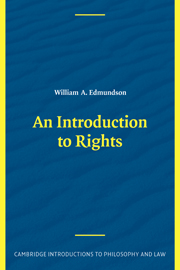Book contents
- Frontmatter
- Contents
- List of Tables
- Preface
- Part One The First Expansionary Era
- Part Two The Second Expansionary Era
- 6 The Universal Declaration, and a Revolt Against Utilitarianism
- 7 The Nature of Rights: “Choice” Theory and “Interest” Theory
- 8 A Right to Do Wrong? Two Conceptions of Moral Rights
- 9 The Pressure of Consequentialism
- 10 What Is Interference
- 11 The Future of Rights
- 12 Conclusion
- Bibliographical Notes
- References
- Index
7 - The Nature of Rights: “Choice” Theory and “Interest” Theory
Published online by Cambridge University Press: 08 January 2010
- Frontmatter
- Contents
- List of Tables
- Preface
- Part One The First Expansionary Era
- Part Two The Second Expansionary Era
- 6 The Universal Declaration, and a Revolt Against Utilitarianism
- 7 The Nature of Rights: “Choice” Theory and “Interest” Theory
- 8 A Right to Do Wrong? Two Conceptions of Moral Rights
- 9 The Pressure of Consequentialism
- 10 What Is Interference
- 11 The Future of Rights
- 12 Conclusion
- Bibliographical Notes
- References
- Index
Summary
In our thinking about rights, we have to try to avoid confusing questions of two different kinds, one of which has been called “conceptual,” and the other “justificatory.” Conceptual questions are questions about what rights are, what their makeup is, and what follows from an assertion that X has a right of such-and-such a description. Hohfeld's work is an example of conceptual inquiry in its purest form. Justificatory questions, in contrast, focus on the grounds for, and reasons behind, the distribution of rights. Granted that a right is a certain kind of thing, why should we think that any exist? What grounds could there be for assigning rights? What purposes do rights serve, and could we do without them?
The distinction between the conceptual and the justificatory is not razor-sharp, and often the two exert influence on each other. Our conceptual picture of what a right is has been shaped by factors that involve judging what a right would have to look like to be worth having. Making this kind of judgment goes beyond simply registering what might or might not sound “odd” to our ears as a matter of ordinary usage. If, for example, a right were a mere Hohfeldian permission to φ, it might seem to be a trivial thing unless it were coupled with a permission not to φ.
- Type
- Chapter
- Information
- An Introduction to Rights , pp. 119 - 132Publisher: Cambridge University PressPrint publication year: 2004



